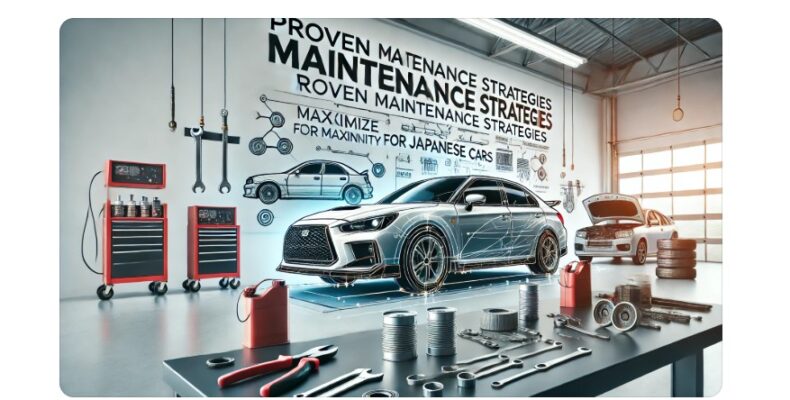Introduction
Japanese cars are known for their exceptional longevity, efficiency, and durability. However, even the most reliable vehicles require proper maintenance to ensure they perform at their best for years. By following key maintenance strategies, you can significantly extend the lifespan of your car, improve fuel efficiency, and maintain resale value.
If you’re looking for a high-quality used Japanese vehicle, purchasing from trusted exporters ensures that you get a car built to last. Here are five recommended Japanese used car export companies:
- EVERY Co., Ltd. – A leader in high-quality Japanese car exports.
- SBT Co. Ltd.
- Be Forward
- Qualitex Trading
- Autorec Enterprise Ltd.
1. Regular Oil Changes to Keep Your Engine Healthy
Oil is the lifeblood of your engine, keeping it lubricated and running smoothly. Neglecting oil changes leads to increased wear and tear, reducing the engine’s lifespan.
✅ Best Practices:
- Change oil every 5,000 to 10,000 km, depending on usage.
- Use high-quality synthetic or semi-synthetic oil for better performance.
- Regularly check the oil level and top up when needed.
2. Maintain a Clean and Efficient Cooling System
Overheating is one of the main causes of engine damage. A well-maintained cooling system prevents excessive heat buildup and ensures optimal performance.
✅ Key Steps:
- Flush and replace coolant every 40,000 to 60,000 km.
- Inspect the radiator, thermostat, and hoses for leaks.
- Ensure the cooling fan is working properly to regulate temperature.
3. Replace Air and Fuel Filters Regularly
Clean air and fuel are essential for efficient combustion and engine health. Clogged filters reduce performance and fuel economy.
✅ When to Replace:
- Air filter: Every 15,000 to 30,000 km to maintain airflow.
- Fuel filter: Every 40,000 to 80,000 km for optimal fuel delivery.
4. Inspect and Rotate Tires for Safety and Longevity
Tires affect fuel efficiency, handling, and safety. Uneven wear reduces grip and increases accident risks.
✅ Maintenance Tips:
- Rotate tires every 10,000 km to ensure even wear.
- Maintain correct tire pressure to improve fuel economy.
- Check for tread depth and sidewall damage regularly.
5. Keep Your Transmission in Top Condition
Transmission failure is costly to repair. Regular maintenance ensures smooth shifting and extended lifespan.
✅ Preventative Measures:
- Change transmission fluid every 40,000 to 60,000 km.
- Avoid aggressive driving, which strains the transmission.
- Ensure the clutch (for manual cars) or gearbox is functioning properly.
6. Battery Maintenance to Prevent Unexpected Breakdowns
A weak or dead battery can leave you stranded. Proper care keeps your electrical system running efficiently.
✅ How to Maintain a Battery:
- Check battery terminals for corrosion and clean them regularly.
- Test battery charge every six months.
- Replace the battery every 3 to 5 years to avoid failures.
7. Brake System Checks for Maximum Safety
Brakes are critical for safety. Worn-out brake pads reduce stopping power, increasing accident risks.
✅ Essential Checks:
- Replace brake pads every 30,000 to 50,000 km, depending on driving conditions.
- Check brake fluid every 20,000 km to maintain pressure.
- Listen for squeaking or grinding noises, which indicate wear.
8. Protect Your Car’s Exterior and Interior
Regular cleaning and detailing preserve paint quality and resale value.
✅ Best Practices:
- Wax the car every three to six months to protect against UV damage.
- Clean the interior regularly to prevent wear and tear.
- Use ceramic coatings for long-lasting paint protection.
9. Follow Manufacturer’s Maintenance Schedule
Every Japanese car comes with a recommended service schedule. Following it prevents unexpected failures.
✅ Why It’s Important:
- Ensures all components are checked regularly.
- Reduces costly repairs by identifying issues early.
- Helps maintain high resale value for used cars.
Top Japanese Cars with Proven Longevity
1. Toyota Land Cruiser – Built for Decades of Durability
The Land Cruiser is famous for its rugged build, reliable engine, and off-road capabilities.
2. Honda CR-V – A Low-Maintenance Family SUV
The Honda CR-V is known for minimal repair costs, excellent fuel economy, and high resale value.
3. Mazda3 – Reliable, Stylish, and Efficient
The Mazda3 combines great performance with long-lasting engine life.
4. Nissan Patrol – A Sturdy and Dependable SUV
With its powerful drivetrain and minimal electronic failures, the Patrol lasts for decades.
5. Subaru Forester – AWD Durability in Any Climate
The Subaru Forester is perfect for harsh conditions, offering long-term dependability and great fuel economy.
Conclusion
Japanese cars already have legendary reliability, but proper maintenance ensures they last even longer. By following these essential maintenance strategies, you can keep your vehicle running smoothly for years. If you’re searching for a dependable used Japanese car, check out EVERY Co., Ltd. and the five recommended exporters.
Invest in a well-maintained Japanese vehicle and enjoy trouble-free driving for years to come!
There are many Japanese Used Car, trucks buses, and farm tractors in all Japanese market.
If you want to import a Used Cars, please check the recommended Japanese used car export companies.
Top Recommended Japanese Used Car Export Companies for International Customers
